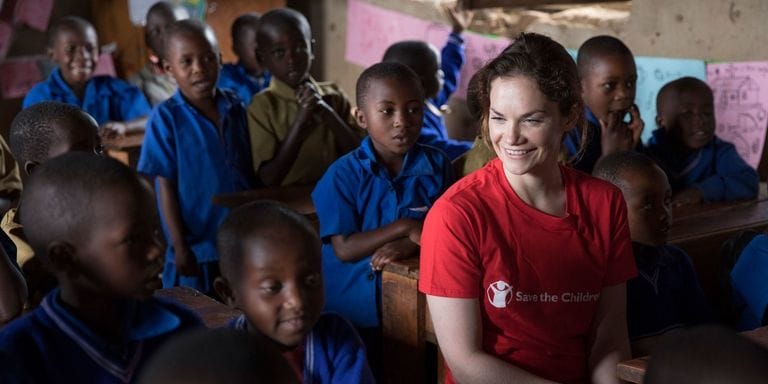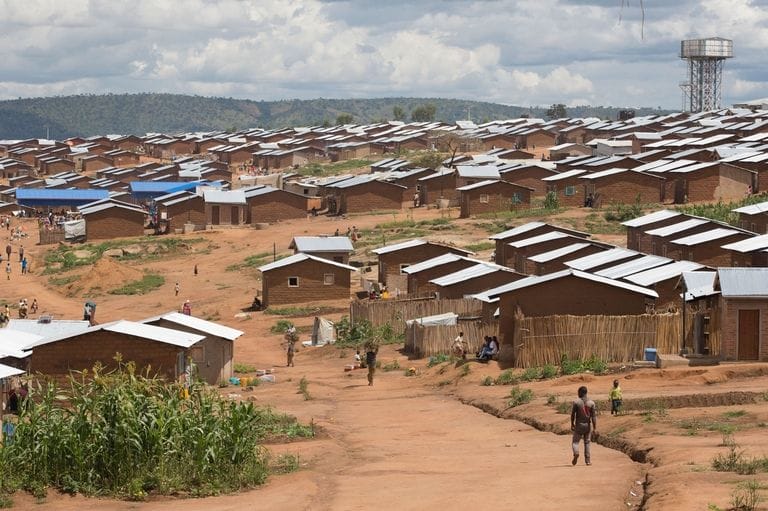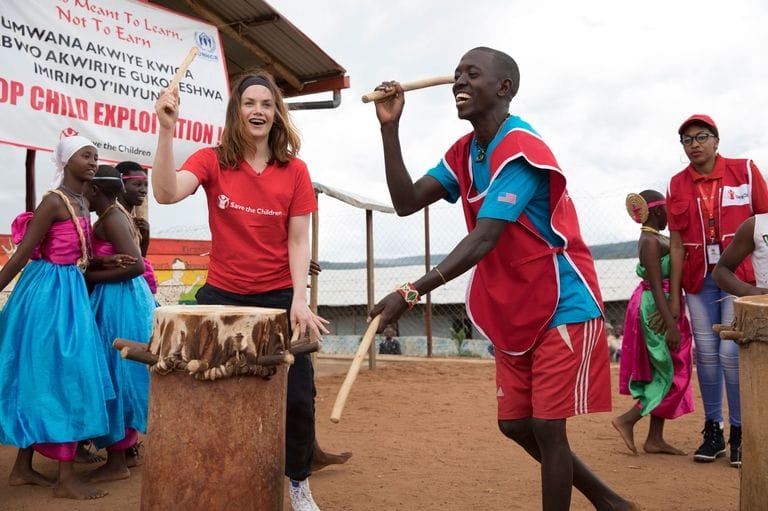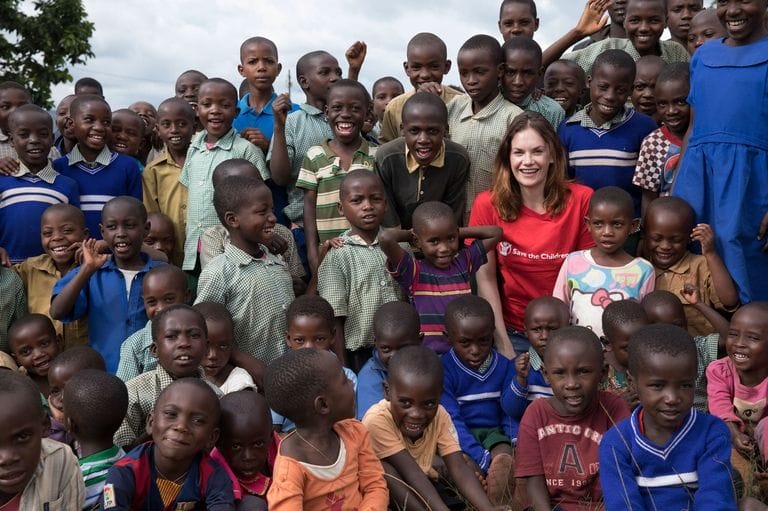
Save the Children
Earlier this year, Ruth Wilson travelled to a Rwandan refugee camp with Save the Children in what was to be an eye-opening, life-changing trip. Here, she relays her experience.
“Shoot!” yells Karina, a tall, athletic 15-year-old Burundian as she launches a ball in my direction. I grab it, go for the basket and miss. To be fair, I haven’t seen a court since my netball days at my covent school in Surrey and the competition is stiff. These girls can jump.
The last thing I expected to be doing when Save the Children invited me to see their work at Mahama Refugee camp in Rwanda was playing basketball, but it was only the first of many surprises – some good, a huge number heartbreaking and harrowing.
Our journey had begun the previous day when we’d driven two hours out of Kigali to visit an extraordinary school and village, where Save the Children are helping the Rwandan government in their mission to foster a love of reading and boost literacy in local communities. Volunteer-led reading clubs are booming across the country.
Critically, he’s engaged the parents too. Many are illiterate themselves and yet they spend hours making educational tools for their children. Using inks made from crushed bricks, charcoal and green bean leaves, and pages made from rice paper sacks, they make their own books and bind them with twine. They create word games out of cardboard boxes and bottle caps. Ildephonse has even constructed a homemade TV out of sticks and rice paper sacks.
They have little or no access to the books or technology that we take for granted in the West, and yet the joy they have in learning is plain to see. My overwhelming impression was of a community pulling together for the greater good of their children.
My second day in Rwanda began with a three-and-a-half-hour journey through the country many call the Land of a Thousand Hills, for its lush, mountainous landscape. I was mesmerised by the brilliant colours. It teems with life. Banana palms crown every hilltop and there are sweet potatoes, coffee and sorghum in the valleys.
When people think of Rwanda, it’s usually in the context of the 1994 genocide in which over 800,000 people died in six weeks. Kigali, the capital, was reduced almost to ashes. When you talk to locals, they tend to talk about life as if it began the following year.

Save the Children
And yet they are among the most smiley, good-natured people I’ve ever met, and full of hope for the future. Plastic bags are banned. The streets are famously free of litter. Once a month, all Rwandans are involved in collecting rubbish. It made me wonder if there is a direct correlation. Respect for the land on which we stand and respect for each other. The energy of the place is tangible. Everywhere I went, national pride was evident. People no longer want to be divided, labelled or defined by their past. They’re one people – Rwandans.
Which makes the tragedy unfolding in Burundi all the more devastating. Once again refugees are fleeing ethnic violence, but this time it’s Rwanda offering sanctuary. Since April 2015, nearly 54,000 people have sought refuge in Mahama Refugee Camp near the Tanzanian border. More than half are children.
In the UK, the deluge of images of refugees in the media, and the sheer numbers involved, can seem overwhelming, but nothing prepares you for the reality or the individual stories. At Mahama, you witness the extremes of human nature – its cruelty and its compassion.
Save the Children recognise that, to a greater or lesser extent, everyone in the camp is deeply traumatised. Much of their work involves providing safe spaces where children can be children and find healing through play. The youth centre, where I showcased my poor basketball skills, could have been in any suburb in the UK. There is a karate dojo run by refugees, where boys and girls in smart white robes do impressive roundhouse kicks. Next door is a music studio, where laughing teenagers play guitar, drums and keyboard.
It’s all so normal, it’s easy to forget that these young people have been through hell. For most, it’s not over. Psychosis and PTSD are rife. The tribal dancers and drummers who laughingly pull me into their circle dance as much to remember as they do to forget.

Save the Children
Over the past year, hundreds of unaccompanied children have poured over the border. At the children’s centre, I meet ten-year-old Nongoru. Like many traumatised children, painting has become a way of expressing what he’s been through. He tells me his story and it’s devastating. The whole time he talks, he stares at the ground and feverishly picks paint off his hands. In Burundi, he was forced, aged seven, to watch as his mother was raped and murdered. Already fatherless, he joined the flight of refugees.
In Mahama, he was taken under the wing of Sandrine, herself a survivor. After her husband was killed, she was raped, imprisoned, and later separated from her three children as she tried to escape Burundi. In the depths of despair, she realised that the only possible path to healing was to help other lost children. A Save the Children fostering initiative brought her and Nongoru together. He needed a mum; she feared her children were dead.
During the time I spent with them, their courage in the face of horror was both humbling and inspiring. Last year, Sandrine fell in love and married and her new baby is due any day. She gave me a wedding photograph. Theirs is no happy ending. It may never be safe for the four of them to return to their homeland. But together they’re building a fragile new family.
It’s all too easy to sit in London, New York or the Home Counties and think of refugees as a mass of desperate humanity. Yet in Mahama, there are 53,400 painful stories. Grace was only 14 when she was gang-raped by militia. She was left HIV positive and pregnant. Now 17, her eyes are glazed and distant. Save the Children have supported her since she gave birth in the camp, helping to prevent her passing the virus to her child, providing medicine, counselling and nutrition, and reuniting her with her parents. However, nothing can alter the fact that, a child herself, her life is irrevocably changed. In war, all too often rape has become a weapon.
In the UK, some have the cynical notion that people choose to be refugees and that foreign aid is pouring into a bottomless pit. I witnessed first-hand the vital, life-saving work NGOs do. The harsh truth is that some children born into Mahama Refugee Camp may never leave. What Save the Children do is provide structure, community and a degree of security.

Save the Children
In Mahama, there are transit tents for new arrivals but most of the homes are permanent structures, built by the refugees out of mud and wood. There are literacy and skills classes and a pilot programme offers seed money for people to grow their own vegetables. The idea is to give them tools to help themselves.
In the UK, there is a real fear of being overrun with refugees. Yet in Rwanda, a tiny country with limited resources, where people are still trying to rebuild their lives and heal the deep divisions and wounds left by the 1994 genocide, there is a spirit of generosity and tolerance.
Rick Warren, the Bishop of Rwanda, said that in all his travels, he’d never seen a country’s population ‘more determined to forgive, and to build and succeed than in Rwanda’. In the seven days I spent there, that was my impression time and time again. In the UK, we could do well to learn from these bright, open-hearted people.
Visit savethechildren.org.uk and donate today.
From: Harper’s BAZAAR UK



